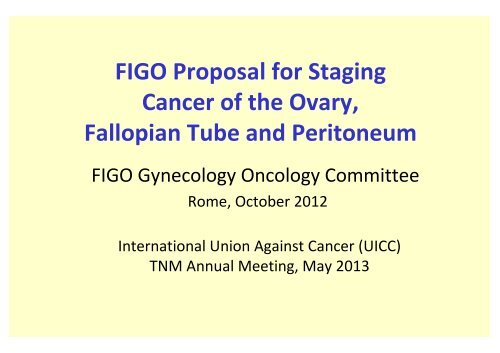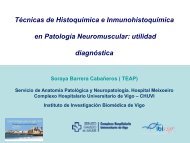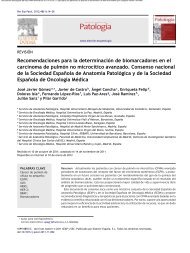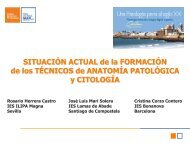FIGO Proposal for Staging Cancer of the Ovary, Fallopian Tube and ...
FIGO Proposal for Staging Cancer of the Ovary, Fallopian Tube and ...
FIGO Proposal for Staging Cancer of the Ovary, Fallopian Tube and ...
Create successful ePaper yourself
Turn your PDF publications into a flip-book with our unique Google optimized e-Paper software.
<strong>FIGO</strong> <strong>Proposal</strong> <strong>for</strong> <strong>Staging</strong><strong>Cancer</strong> <strong>of</strong> <strong>the</strong> <strong>Ovary</strong>,<strong>Fallopian</strong> <strong>Tube</strong> <strong>and</strong> Peritoneum<strong>FIGO</strong> Gynecology Oncology CommitteeRome, October 2012International Union Against <strong>Cancer</strong> (UICC)TNM Annual Meeting, May 2013
Organizations who gave input• AJCC• SGO• ESGO• GCIG• National cancer researchgroup <strong>of</strong> NationalInstitute <strong>for</strong> HealthResearch, UK• EORTC• UICC• IGCS• Korean Society <strong>of</strong> GynOncology• Japanese Society <strong>of</strong> GynOncology
Clinical <strong>Staging</strong> <strong>of</strong> <strong>Cancer</strong> <strong>of</strong> <strong>the</strong><strong>Ovary</strong>, <strong>Fallopian</strong> <strong>Tube</strong> <strong>and</strong>Peritoneum (<strong>FIGO</strong> 2012)
Clinical <strong>Staging</strong> <strong>of</strong> <strong>Cancer</strong> <strong>of</strong> <strong>the</strong> <strong>Ovary</strong><strong>Fallopian</strong> <strong>Tube</strong> <strong>and</strong> Peritoneum(<strong>FIGO</strong> 2012)OV Primary tumor, ovary TovFT Primary tumor, fallopian tube TftP Primary tumor, peritoneum TpU Primary tumor cannot be assessed Tu
Histologic Subtypes <strong>of</strong> OvarianCarcinomas• Serous – high grade• Serous – low grade• Clear cell• Endometrioid• Mucinous
New classification: FrequencyHG serousLG serousClear cellEndometrioidMucinousUnclassifiableTP44
HGCLGSCMCECCCC
Ovarian Carcinomas:Stage at presentation (early vs advanced) according toHistologic SubtypeStageClearCellEndometrioid Mucinous Low-GradeSerousHigh-GradeSerousCarcinomaNOSI-II 26.2% 29.4% 8.5% 1.9% 30% 4.0%III-IV 4.9% 3.5% 1.1% 4.9% 84.2% 1.4%All 10.4% 10.3% 3.6% 3.5% 70% 2.1%Gilks CB et al.Mod Pathol 2009; 22:215A
Endometrioid <strong>and</strong> Clear Cell Tumors developfrom Ovarian EndometriosisRetrogrademenstruationEndometriosisCarcinomaBorderlinetumor
Ovarian Atypical Endometriosis →Endometrioid or Clear Cell Carcinomas15-32% <strong>of</strong> cases
Clear cell carcinoma
Designate Histological type• High-grade serous (HGSC)• Endometrioid (EC)• Clear cell (CCC)• Mucinous (MC)• Low grade serous (LGSC)• O<strong>the</strong>r• Cannot be classified• Germ cell (GCT)• Sex cord stromal tumour (SCST)
ITumor confined to ovaries or fallopian tube(s) T1IA Tumor limited to one ovary (capsule intact) or fallopian tube, T1aNo tumor on ovarian or fallopian tube surfaceNo malignant cells in <strong>the</strong> ascites or peritoneal washingsIBTumor limited to both ovaries (capsules intact) or fallopian tubes T1bNo tumor on ovarian or fallopian tube surfaceNo malignant cells in <strong>the</strong> ascites or peritoneal washingsIC Tumor limited to one or both ovaries or fallopian tubes, T1cwith any <strong>of</strong> <strong>the</strong> following:IC1 Surgical spillIC2 Capsule ruptured be<strong>for</strong>e surgery or tumor on ovarian or fallopian tube surfaceIC3 Malignant cells in <strong>the</strong> ascites or peritoneal washings
Stage 1 Peritoneal <strong>Cancer</strong>• <strong>FIGO</strong> staging system is used with <strong>the</strong>underst<strong>and</strong>ing that it is not possible to have astage I peritoneal cancer
IITumor involves one or both ovaries or fallopian tubes withpelvic extension (below pelvic brim) or primary peritonealcancer T2IIA Extension <strong>and</strong>/or implants on <strong>the</strong> uterus <strong>and</strong>/or fallopiantubes/<strong>and</strong>/or ovaries T2aIIB Extension to o<strong>the</strong>r pelvic intraperitoneal tissues T2bIIC Any <strong>of</strong> above, but with ascites or positive peritoneal washings
Ovarian Carcinomas involvingRetroperitoneal LNs• Less than 10% <strong>of</strong> ovarian carcinomas haveextended beyond <strong>the</strong> pelvis with exclusivelyRetroperitoneal Lymph Node involvement• Literature evidence indicates that <strong>the</strong>se caseshave better prognosis than tumors withabdominal peritoneal involvement• No pathological distinction between high-gradeserous <strong>and</strong> low-grade serous carcinomas
New Stage III - <strong>FIGO</strong> 2012IIIOne or both ovaries, fallopian tubes, or primary peritoneal cancer withpathologically proved spread to <strong>the</strong> peritoneum outside <strong>the</strong> pelvis <strong>and</strong>/ormetastasis to <strong>the</strong> retroperitoneal lymph nodesIIIA Metastasis to <strong>the</strong> retroperitoneal lymph nodes with or without microscopicperitoneal involvement beyond <strong>the</strong> pelvisIIIA1Positive retroperitoneal lymph nodes onlyIIIA1(i) Metastasis (≤ 1 cm in size)IIIA1(ii) Metastasis (> 1 cm in size)IIIA2Microscopic extrapelvic peritoneal involvement with or without positiveretroperitoneal lymph nodesIIIB Macroscopic peritoneal metastasis beyond <strong>the</strong> pelvis 2 cm or less with or withoutmetastasis to <strong>the</strong> retroperitoneal lymph nodesIIIC Macroscopic peritoneal metastasis beyond <strong>the</strong> pelvis more than 2 cm with orwithout metastasis to <strong>the</strong> retroperitoneal lymph nodes(Note 1: includes extension <strong>of</strong> tumor to capsule <strong>of</strong> liver <strong>and</strong> spleen without parenchymalinvolvement <strong>of</strong> ei<strong>the</strong>r organ)
Ovarian CarcinomasLow-grade serous carcinomas may arisein lymph nodes from endosalpingiosisDjordjevic B, Malpica A.Am J Surg Pathol 2010, 2012
SBT in Lymph Nodes (30%)LN: Mullerian cysts (endosalpingiosis)SBT in lymph node
SBT in lymph node
SBT in lymph node (fibrosis)
LN – Endosalpingiosis SBT LGSCMetastatic HGSC in LN
Ovarian Carcinomas involving Lymph Nodes• Less than 10% <strong>of</strong> ovarian carcinomas have extended beyond <strong>the</strong> pelvis wi<strong>the</strong>xclusively Retroperitoneal Lymph Node involvement• Literature evidence indicates that <strong>the</strong>se cases have better prognosis thantumors with abdominal peritoneal involvement• Low-grade serous carcinomas may arise in lymph nodes fromendosalpingiosis• Most <strong>of</strong> <strong>the</strong>se cases probably represent separate primary low-gradeserous carcinomas arising in lymph nodes from endosalpingiosiswhich explains <strong>the</strong>ir favorable prognosis
New Stage III - <strong>FIGO</strong> 2012
Stage IIIIII Tumor involves one or both ovaries, fallopian tubes, orprimary peritoneal cancer, with cytologically or histologicallyconfirmed spread to <strong>the</strong> peritoneum outside <strong>the</strong> pelvis <strong>and</strong>/ormetastasis to <strong>the</strong> retroperitoneal lymph nodesT1/T2/T3aN1IIIA1 Positive retroperitoneal lymph nodes only (cytologicallyor histologically proven)IIIA1 (i) Metastasis ≤ 10 mm in greatest dimensionIIIA1 (ii) Metastasis > 10 mm in greatest dimensionIIIA 2 Microscopic extrapelvic (above <strong>the</strong> pelvic brim)peritoneal involvement with or without positive retroperitoneallymph nodesT3a/T3aN1
Stage IIIIIIB Macroscopic peritoneal metastasis beyond <strong>the</strong> pelvis2 cm or less in greatest dimension, with or without metastasis to <strong>the</strong>retroperitoneal lymph nodesT3b/T3bN1IIIC Macroscopic peritoneal metastasis beyond <strong>the</strong> pelvismore than 2 cm in greatest dimension, with or without metastasis to<strong>the</strong> retroperitoneal lymph nodes (Note 1)T3c/T3cN1[Note 1: includes extension <strong>of</strong> tumour to capsule <strong>of</strong> liver <strong>and</strong> spleen withoutparenchymal involvement <strong>of</strong> ei<strong>the</strong>r organ ]T3c/T3cN1
IVDistant metastasis excluding peritoneal metastasesStage IV A: Pleural effusion with positive cytologyStage IV B: Metastases to extra-abdominal organs(including inguinal lymph nodes <strong>and</strong> lymph nodesoutside <strong>of</strong> abdominal cavity)(Note 2: Parenchymal metastases are Stage IV B)
Stage IV• Stage IVA: Pleural effusion with positive cytology• Stage IVB: Parenchymal metastases <strong>and</strong> metastases toextra-abdominal organs (including inguinal lymph nodes<strong>and</strong> lymph nodes outside <strong>of</strong> abdominal cavity)Any T, Any N, M1
Notes• The primary site i.e: ovary, fallopian tube or peritoneum, shouldbe designated where possible.• In some cases, it may not be possible to clearly delineate <strong>the</strong>primary site <strong>and</strong> <strong>the</strong>se should be listed as ‘undesignated’• The histological type should be recorded• The staging includes a revision <strong>of</strong> <strong>the</strong> stage III patients <strong>and</strong>allotment to stage IIIA1 is based on spread to <strong>the</strong> retroperitoneallymph nodes without intraperitoneal dissemination, because ananalysis <strong>of</strong> <strong>the</strong>se patients indicates that <strong>the</strong>ir survival issignificantly better than those who have intraperitonealdissemination
Notes• Involvement <strong>of</strong> retroperitoneal lymph nodes must beproven cytologically or histologically• Extension <strong>of</strong> tumour from omentum to spleen or liver(Stage IIIC) should be differentiated from isolatedparenchymal metastases (Stage IVB)
The five most common types <strong>of</strong> ovarian carcinomaHigh-gradeserousClear cell Endometrioid Mucinous Low-gradeserousUsual stage at diagnosisAdvanced Early Early EarlyEarly oradvancedPresumed tissue o<strong>for</strong>igin /precursor lesion<strong>Fallopian</strong> tube ortubal metaplasiain inclusions <strong>of</strong>OSEEndometriosis,aden<strong>of</strong>ibromaEndometriosis,aden<strong>of</strong>ibromaAdenoma–borderline –carcinomasequence;teratomaSerousborderlinetumorGenetic riskBRCA1/2 ? HNPCC ? ?Significant molecularabnormalitiesp53 <strong>and</strong> pRbpathwayHNF-1βARID1APTEN, β-Catenin, K-rasMI, ARID1AK-rasBRAF orK-rasProliferationHigh Low Low Intermediate LowResponse to primarychemo<strong>the</strong>rapyPrognosis80% 15% ? 15% 26-28%Poor Intermediate Favorable Favorable Favorable
PIK3CA20q ampKRASBRAFERB2PTENb-cateninClear CellEndometrioidLow-gradeKRASMucinousTP53/Rb pathwayChromosomalinstabilityHig-grade Serous
Thank you<strong>for</strong> yourattention
Type IPIK3CA20q ampKRASBRAFERB2PTENb-cateninClear CellEndometrioidLow-gradeKRASMucinousTP53/Rb pathwayChromosomalinstabilityHig-grade SerousType II

















